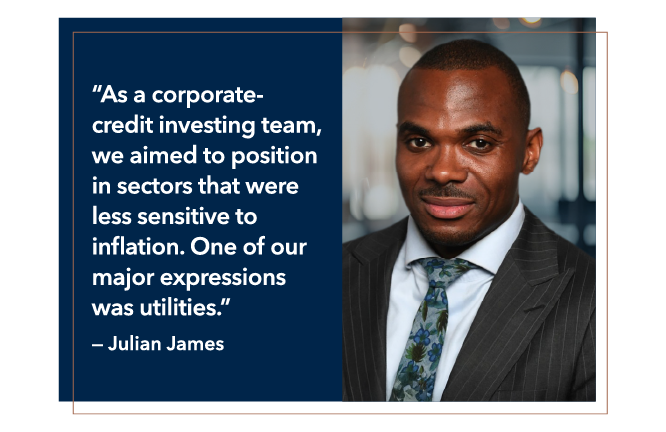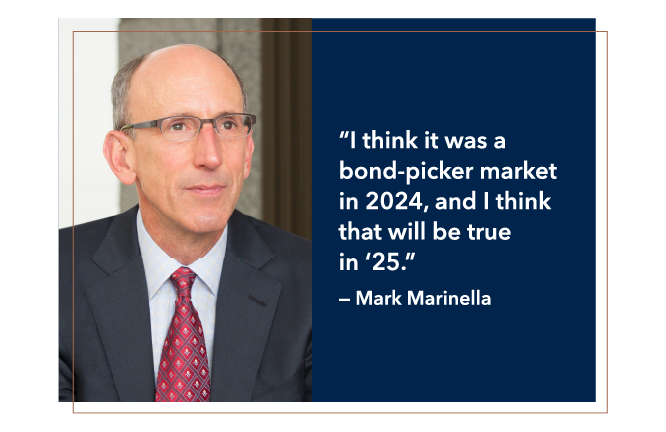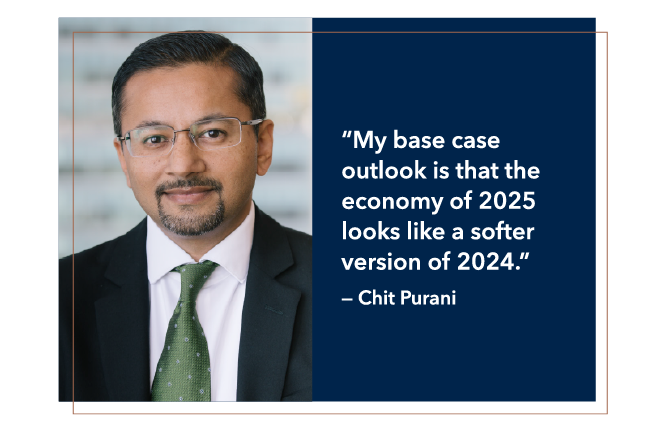Risk
Bonds
With the Federal Reserve lowering interest rates and the U.S. economy holding onto a good head of steam, 2025 looks poised to build on last year’s solid economic growth. This outlook generally bodes well for the fixed income market — but as history has shown, plenty of unknowns could intrude on this rosy scenario in the coming 12 months.
A big question surrounds inflation. Though consumer price growth has retreated dramatically from its pandemic-era peak, several forces threaten to push rates back up again, including developments in the job market and the potential impact of tariffs.
We gathered fixed income portfolio managers Chit Purani and Mark Marinella, and analysts Julian James and Shriya Gehani, to discuss this environment and how they’re preparing for the year ahead.

A key theme last year was the surprising resilience of the U.S. economy, even in the face of higher interest rates. What’s your sense of where the economy’s heading, and what does that mean for bonds?
Chit Purani: The resilience of U.S. economic growth in 2024 was notable. Despite the high fed funds rate over this tightening cycle, the U.S. broadly remains less interest-rate sensitive than many had expected. Inflation moderated for most of 2024, and wage and job growth continue to support consumption, despite the unemployment rate gradually rising. Factors like government spending and productivity appear to be tailwinds as well. My base case outlook is that the economy of 2025 looks like a softer version of 2024.
However, there’s always the potential for some exogenous shock that’s not on our radar. And this year I believe some of the “known unknowns” — those things we know we don’t have a full picture of — could also play a significant role. Markets won’t necessarily wait for a fuller picture before trading on information, such as details around policy implementation or signs of weakening labor markets. This could create a lot of volatility.
Mark Marinella: I’ve been very surprised at how resilient the U.S. economy has been. I’ve been pleased that inflation has come down and seems to be reasonably under control. As we start 2025, it’s not too hot, it’s not too cold, it may be just right. Yet that makes me a little anxious. I don’t see a dominant theme this year. In comparison, in 2022 I think we were all of a similar mindset: Inflation was rapidly rising and the Fed came around to the conclusion that its
No. 1 job was to get inflation down. So the reasonably high probability that rates were going to go higher became a dominant theme in portfolios.

Julian James: I’d start with the consumer. The bottom quintile, maybe the bottom two quintiles, of the U.S. consumer are probably getting a bit weaker. But I think that’s more than been made up for by the strength from the upper rungs of the consumer ladder. That’s something I expect to continue.
Broadly, we’re looking at a scenario where corporate managements are relatively optimistic about the near-term future. That could be further ignited by a more benign regulatory environment under the Trump administration; depending on how tariffs play out, if they’re more of a threat than an actual scenario, then we’re probably looking at a more benign interest rate environment as well.
Of course, interest rates have been a defining element of the economic outlook, and that goes double for fixed income. How are you thinking about Fed actions?
Shriya Gehani: The market has somewhere around half a percentage point of cuts priced for this year. I don’t have too much reason to push back against that, but I don’t necessarily want to position portfolios to rely on that. If the Fed is on a cutting cycle, that is a very benign backdrop for assets with higher credit risk and for mortgages in particular. We’ve already moved a decent amount. But as Mark said, sometimes you get market signals and sometimes you don’t. There doesn’t seem to be a dominant theme now, and what I like about mortgages is you get paid to wait.
I believe we are on a generally disinflationary path, but it’s likely to be bumpy. You’re going to have sectors that are volatile. Still, if you take a bigger-picture view, the path of movement is consistent with what the Fed would like to see in order to continue cutting. Additionally, labor market softness is likely to keep the Fed on this path even if there are hiccups in inflation.

Marinella: I don’t remember a prior cycle where the economy didn’t run into trouble after the Fed tightened aggressively in a short period of time. I don’t want to overuse the word “unique,” but this is different — there’s the aftermath of a global pandemic, the massive amount of fiscal and monetary easing government support, and a massive increase in the Fed’s balance sheet.
It may just mean that this cycle takes much longer to finish, and I think the market showed that. There’s been a lot of volatility in the bond market, and I think it’s because the traditional post-aggressive-tightening economy hasn’t really happened. These are new and different things because we started out new and different.
Gehani: Just the existence of the multi-trillion Fed balance sheet has been a giant easing mechanism. It’s hard to tell whether the tightening is just going to take a very long time to play out — the type of consequences we would normally think of after five percentage points of hikes, we’re just not seeing them.
Given all that, how are each of you positioning portfolios or thinking about your coverage areas?
Purani: To determine where value potentially exists in the market, I try to establish a probability distribution across different macro scenarios and a related fair value range for fixed income risk factors, then attempt to compare that to what’s priced into the markets. It’s admittedly a blend of art and science.
In this context, it’s quite clear that there’s little margin for error in assets with higher credit risk. As a result, I continue to move higher in quality across fixed income sectors and issuers when I don’t have to give up much yield or spread to do so, in order to enhance the resiliency and liquidity of portfolios.

Marinella: I think it was a bond-picker market in 2024, and I think that will be true in ‘25.
In the muni market, we have what we call the base curve bonds, which are investment-grade securities that make up the yield curve and trade very frequently. Those are at narrower spreads, much like the corporate bond market and taxable side that Chit describes. But there are sectors in munis that have dramatically lagged since COVID and have not come close to recovering.
James: As a corporate-credit investing team, we aimed to position in sectors that were less sensitive to inflation. One of our major expressions was utilities. In the utility business model, costs are largely passed through to the customer. There is a lag as various prices inflate, but that’s brief. There really is relatively strong pricing power.
Julian, you cover utilities as an analyst. Could you go a little more in-depth into that sector? I understand that AI is a significant factor there.
James: Let’s start with how utilities make money. They have what is called a “regulated rate base”; you should think about that as the plant, property and equipment needed to provide electric or gas service. Utilities can capitalize that asset base, based on how they’re regulated, through a mix of debt and equity. On the equity side, they’re allowed to earn a regulated rate of return. We call this a cost-of-service business model, and it incentivizes utilities to grow their asset bases. The larger their asset base, the more they can make off it.
AI comes in because it requires data centers, which consume electricity 24/7. There’s probably enough electricity in most markets to satisfy reasonable projections for AI growth through 2027 or 2028, but once we get past that point, we’re going to need significantly more power generation, more natural gas and more renewables. That would allow the utilities to invest more, grow their asset base more and, thus, earn more.
One of the opportunities is in finding companies that are growing due to AI and figuring out if their bonds are mispriced relative to companies that aren’t growing. A second opportunity is to provide capital to those utilities that are growing quickly. We are getting an outsized discount on their bonds when they issue new bonds to fund that capex. Of course, we’re also doing our bread-and-butter work of finding utilities that have other idiosyncratic drivers that are causing the market to undervalue them.
And Shriya, you cover agency mortgage-backed securities — housing bonds from government-supported enterprises like Freddie Mac and Fannie Mae. Such bonds are an important part of many Capital Group portfolios. What are you seeing and hearing there?
Gehani: The Fed being a net seller for the past few years has been a headwind for the asset class, but there are some things that could support the sector. It will be interesting to see what the domestic bank community does next year, given some clarity around regulations and more comfort with attractive mortgage valuations. Perhaps they’ll want to add interest-rate exposure via mortgages.
There are some political developments, as well: I expect the Trump administration to take a few steps toward reducing Fannie’s and Freddie’s footprints. They’ve historically had implicit backing from the U.S. government, but when they entered conservatorship after the global financial crisis of 2008, that became more like an explicit backstop.
Still, affordability is an issue right now. From a political standpoint, I think even toying with the idea of doing something that could increase mortgage rates doesn’t sound that palatable. Another problem: mortgages have become a big part of the investment universe, so changes to that guarantee framework could have many implications. I think they might end some of the pilot programs that have come out or change the pricing for some products, whether it be investor loans or jumbo conforming loans.
That’s another big change this year — President Donald Trump has begun his second term. Do you expect any meaningful changes to the bond market as a result?
Purani: I don’t believe we’ll see the more extreme or blunt implementation of policy measures that have been discussed, as opposed to something more surgical. And in terms of timing, to the extent there are immediate changes, they’re likely to arise in trade, immigration and regulation — areas where the president has more unilateral authority. Taxes and measures like broader fiscal spending must go through Congress and will probably have a longer tail for implementation.
In terms of bond market implications, it’s harder to position for specific policy outcome and related market response, as opposed to positioning against potential overreactions to policy announcements.
Marinella: Last time around, when the Tax Cut and Jobs Act was passed, the initial reaction in munis was negative. I think the TCJA will be extended, so we’ve seen a version of this movie before — that initial reaction was overtaken as munis went off on a rally with the rest of the bond market. Everybody talks about lower taxes potentially weighing on the demand for munis, but the correlation between tax rates and muni returns isn’t very good at all. When big tax cuts happen, people with wealth still have had the highest bracket. They still buy munis.
James: I would say, largely, utilities are insulated. Utility supply chains are relatively contained within the United States, shielding them from potential tariffs. There are some exceptions — think Siemens in Germany, a major producer of wind turbines. But for most of the supply chain that has some international exposure, there usually is a U.S. substitute. There might be some queues if you need to switch from an international provider, but eventually that will be passed through.
There are some questions around the Inflation Reduction Act, which benefits investments in wind, solar and nuclear. If there’s a complete dismantling of the IRA, you would probably see utility companies lower their investment plans. That would probably result in lower earnings, though it might not necessarily be negative from a credit perspective. And if any changes to the IRA are more surgical, I think utilities will find offsets that allow them to invest at the same rates.
Related Insights
Related Insights
-
What L.A. wildfire victims need to know about taxes and other financial matters
-
Risk
Preparing for the unexpected: How to financially plan for an emergency or disaster -
Financial Planning
Tax changes are almost certain. Are you prepared?

 Mark Marinella
Mark Marinella
 Shriya Gehani
Shriya Gehani
 Julian James
Julian James
 Chit Purani
Chit Purani